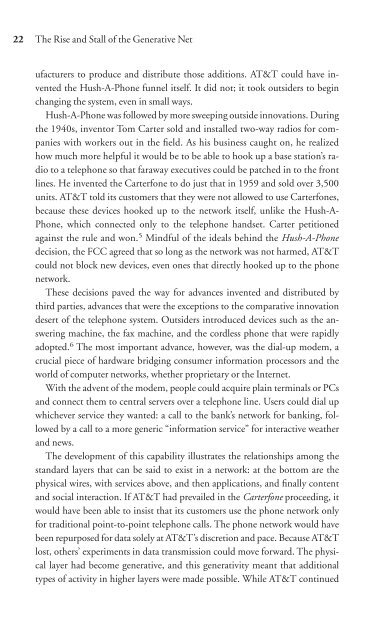Download - Future of the Internet â And how to stop it.
Download - Future of the Internet â And how to stop it.
Download - Future of the Internet â And how to stop it.
You also want an ePaper? Increase the reach of your titles
YUMPU automatically turns print PDFs into web optimized ePapers that Google loves.
22<br />
The Rise and Stall <strong>of</strong> <strong>the</strong> Generative Net<br />
ufacturers <strong>to</strong> produce and distribute those add<strong>it</strong>ions. AT&T could have invented<br />
<strong>the</strong> Hush-A-Phone funnel <strong>it</strong>self. It did not; <strong>it</strong> <strong>to</strong>ok outsiders <strong>to</strong> begin<br />
changing <strong>the</strong> system, even in small ways.<br />
Hush-A-Phone was followed by more sweeping outside innovations. During<br />
<strong>the</strong> 1940s, inven<strong>to</strong>r Tom Carter sold and installed two-way radios for companies<br />
w<strong>it</strong>h workers out in <strong>the</strong> field. As his business caught on, he realized<br />
<strong>how</strong> much more helpful <strong>it</strong> would be <strong>to</strong> be able <strong>to</strong> hook up a base station’s radio<br />
<strong>to</strong> a telephone so that faraway executives could be patched in <strong>to</strong> <strong>the</strong> front<br />
lines. He invented <strong>the</strong> Carterfone <strong>to</strong> do just that in 1959 and sold over 3,500<br />
un<strong>it</strong>s. AT&T <strong>to</strong>ld <strong>it</strong>s cus<strong>to</strong>mers that <strong>the</strong>y were not allowed <strong>to</strong> use Carterfones,<br />
because <strong>the</strong>se devices hooked up <strong>to</strong> <strong>the</strong> network <strong>it</strong>self, unlike <strong>the</strong> Hush-A-<br />
Phone, which connected only <strong>to</strong> <strong>the</strong> telephone handset. Carter pet<strong>it</strong>ioned<br />
against <strong>the</strong> rule and won. 5 Mindful <strong>of</strong> <strong>the</strong> ideals behind <strong>the</strong> Hush-A-Phone<br />
decision, <strong>the</strong> FCC agreed that so long as <strong>the</strong> network was not harmed, AT&T<br />
could not block new devices, even ones that directly hooked up <strong>to</strong> <strong>the</strong> phone<br />
network.<br />
These decisions paved <strong>the</strong> way for advances invented and distributed by<br />
third parties, advances that were <strong>the</strong> exceptions <strong>to</strong> <strong>the</strong> comparative innovation<br />
desert <strong>of</strong> <strong>the</strong> telephone system. Outsiders introduced devices such as <strong>the</strong> answering<br />
machine, <strong>the</strong> fax machine, and <strong>the</strong> cordless phone that were rapidly<br />
adopted. 6 The most important advance, <strong>how</strong>ever, was <strong>the</strong> dial-up modem, a<br />
crucial piece <strong>of</strong> hardware bridging consumer information processors and <strong>the</strong><br />
world <strong>of</strong> computer networks, whe<strong>the</strong>r proprietary or <strong>the</strong> <strong>Internet</strong>.<br />
W<strong>it</strong>h <strong>the</strong> advent <strong>of</strong> <strong>the</strong> modem, people could acquire plain terminals or PCs<br />
and connect <strong>the</strong>m <strong>to</strong> central servers over a telephone line. Users could dial up<br />
whichever service <strong>the</strong>y wanted: a call <strong>to</strong> <strong>the</strong> bank’s network for banking, followed<br />
by a call <strong>to</strong> a more generic “information service” for interactive wea<strong>the</strong>r<br />
and news.<br />
The development <strong>of</strong> this capabil<strong>it</strong>y illustrates <strong>the</strong> relationships among <strong>the</strong><br />
standard layers that can be said <strong>to</strong> exist in a network: at <strong>the</strong> bot<strong>to</strong>m are <strong>the</strong><br />
physical wires, w<strong>it</strong>h services above, and <strong>the</strong>n applications, and finally content<br />
and social interaction. If AT&T had prevailed in <strong>the</strong> Carterfone proceeding, <strong>it</strong><br />
would have been able <strong>to</strong> insist that <strong>it</strong>s cus<strong>to</strong>mers use <strong>the</strong> phone network only<br />
for trad<strong>it</strong>ional point-<strong>to</strong>-point telephone calls. The phone network would have<br />
been repurposed for data solely at AT&T’s discretion and pace. Because AT&T<br />
lost, o<strong>the</strong>rs’ experiments in data transmission could move forward. The physical<br />
layer had become generative, and this generativ<strong>it</strong>y meant that add<strong>it</strong>ional<br />
types <strong>of</strong> activ<strong>it</strong>y in higher layers were made possible. While AT&T continued


